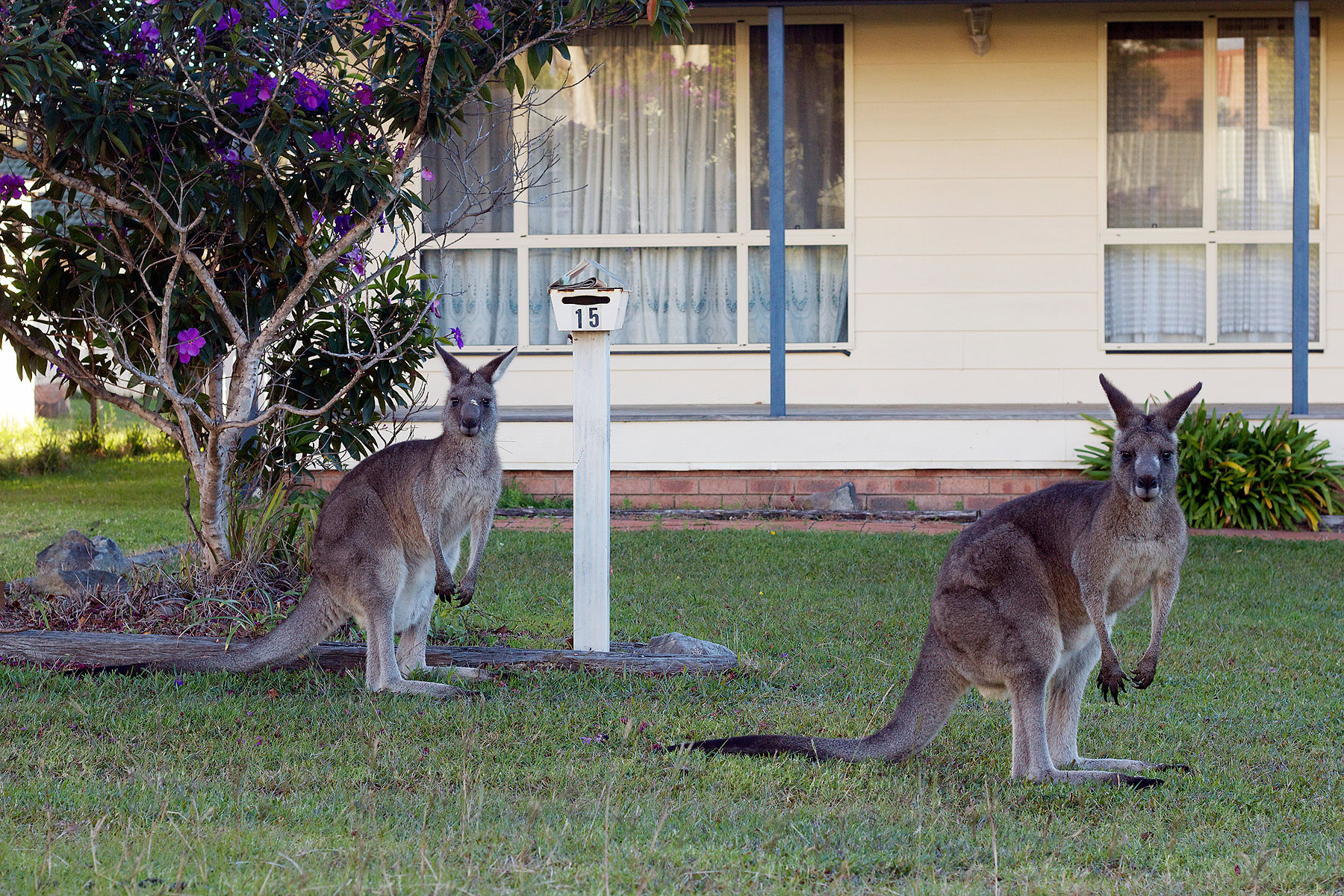
The old cliché about kangaroos hopping down the streets of Australia happens to be true in the national capital Canberra. Set 150 km from the east coast, among vast eucalyptus forests that are heavily prone to drought, the city’s parks, gardens, golf courses and sports grounds have proved irresistible to the iconic marsupial that is featured alongside the emu on Australia’s coat of arms. In fact, some of Canberra’s nature reserves boast the highest densities of kangaroos on the continent.
“Seeing kangaroos in urban areas is one of the best aspects of living in Canberra,” says Tara Ward, a legislative drafter with the Department of the Environment. “It’s one of the top things tourists want to see here because they don’t have to go for long drives to see our native animals.”
Yet interactions between humans and kangaroos can easily turn sour. In 2009, a kangaroo crashed through the window of a Canberra home, terrorized a family and gouged holes in their furniture until it escaped through an open door. In 2010, a footballer was knocked unconscious when he ran into a kangaroo in a Canberra park, while another man received deep gashes to his legs last year when he collided with one on a front lawn during his morning jog. “We both got a nasty fright — and of course when kangaroos are startled they lash out,” the victim, the capital territory’s minister for territory and municipal services Shane Rattenbury, said at the time.
In seeming contradiction to the philosophies of the Australian Greens party he represents, Rattenbury is now spearheading Canberra’s controversial kangaroo cull. Introduced in 2008 to prevent overgrazing, this year’s shoot puts over 1,600 eastern gray kangaroos in the cross hairs. “The primary goal of the conservation cull is to maintain kangaroos at sustainable densities to minimize the impact of heavy grazing on other native fauna and flora,” explains the Territory and Municipal Services website. “High numbers of kangaroos can eat down the ground-layer vegetation so it is no longer able to provide food and shelter for small animals.”
Australian National University conservation expert Professor David Lindenmayer says the science behind the cull is solid. “These woodlands were designed to have major predators like Tasmanian tigers, dingoes and Aboriginal hunters that were the key processes of population regulation,” he says. “And now we have significant amounts of extra water and grass, so it’s a double whammy.”
He adds, “Herbivore overpopulation is not just happening here, but in the U.S. and Patagonia with deer and with other species in different parts of the world. So for animal-welfare groups to say there is no evidence of it happening is like people saying there is no evidence of climate change. The data is very strong.”
Yet one of those welfare groups, Animal Liberation ACT, has thrown the demand for evidence-based environmental management back in the Establishment’s face. Earlier this month, the group’s lawyers, the Animal Defenders Office, persuaded a judge to grant a stay against the kangaroo cull on the basis that the government has failed in its duty to prove the kangaroo cull had improved biodiversity over the past six years.
“They have not collected any baseline data or monitoring data on the conditions of other species on the reserves they say they are saving,” says legislative drafter Ward, who moonlights as a volunteer with the Animal Defenders Office. “If the government wants to go and kill more than 1,600 healthy wild animals, we have to be clear that the science is impeccable before we let them do that.”
“And remember, those 1,600 deaths don’t take into account the joeys that have to be brutally dispatched by shooters after they’ve killed their mothers,” she says. “Part of the applicant’s contention is that it is impossible to carry this out without cruelty being involved.”
David Nicholls, a 70-year-old farmer who spent his whole life working in the bush — two years as a “roo shooter” — agrees. “You try to get clean head shots but it’s difficult because kangaroos are very jumpy — the slightest noise or change in the wind startles them,” he says. “You tell me which Olympic shooter can achieve 100% clean shots every time, even in perfect conditions? The clean-head-shot theory is a myth.”
The hearing to indefinitely end Canberra’s kangaroo cull commences on Thursday and concludes on June 2. In a bid to cool tempers, Rattenbury’s office has announced plans to use the drug deslorelin to neuter 500 eastern grays on a trial basis — the largest neutering drive ever performed on kangaroos. But with costs projected at $830 per animal — three times what it costs to shoot them — and data showing deslorelin can cause cancer, the trial isn’t expected to go mainstream anytime soon. “And even if it does work, those nonbreeding animals will continue to eat large amounts of food throughout their lives,” says Lindenmayer.
“The reality is this debate is not about science or the environment. It’s about people’s value sets,” he says. “Some people look at the world from a purely utilitarian viewpoint; others have a strictly bioethical position.”
More Must-Reads from TIME
- How Donald Trump Won
- The Best Inventions of 2024
- Why Sleep Is the Key to Living Longer
- Robert Zemeckis Just Wants to Move You
- How to Break 8 Toxic Communication Habits
- Nicola Coughlan Bet on Herself—And Won
- Why Vinegar Is So Good for You
- Meet TIME's Newest Class of Next Generation Leaders
Contact us at letters@time.com